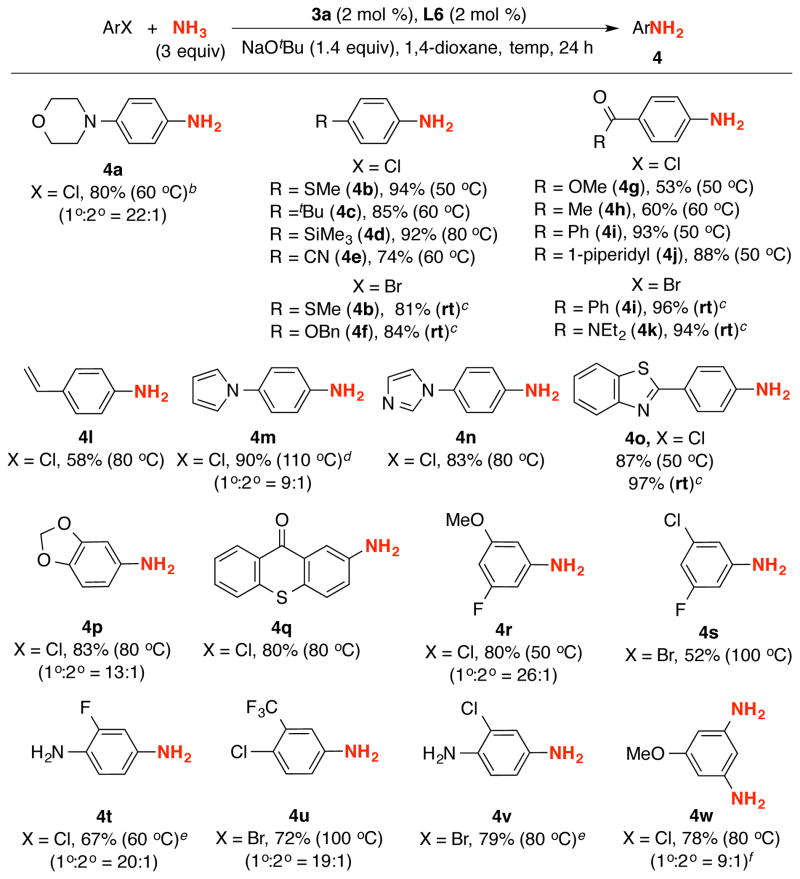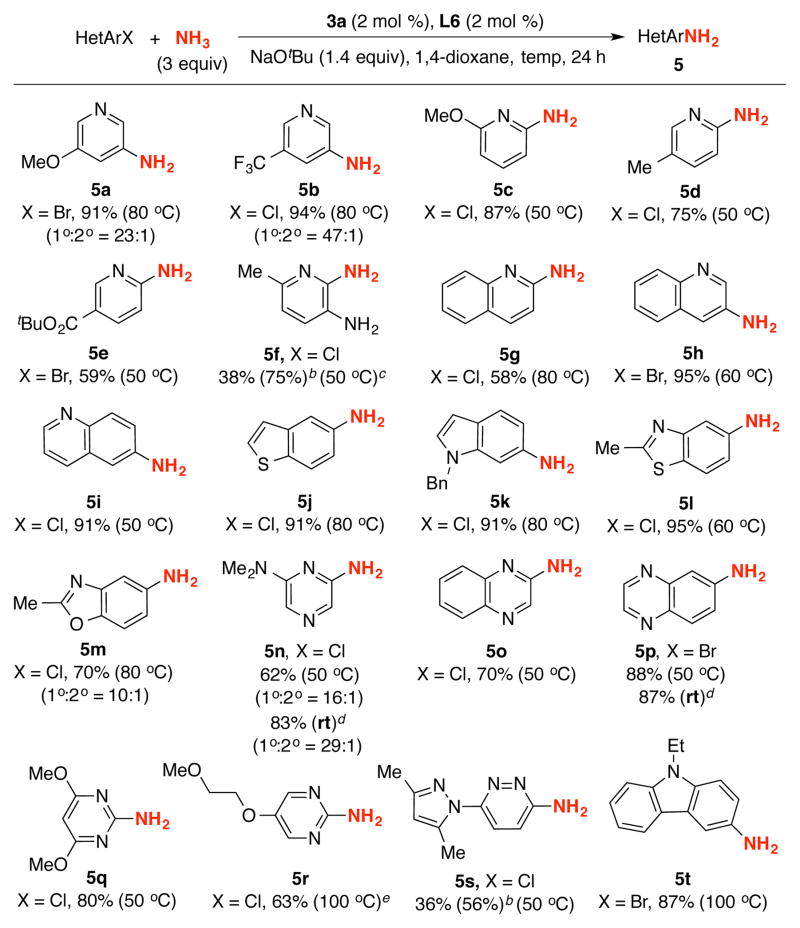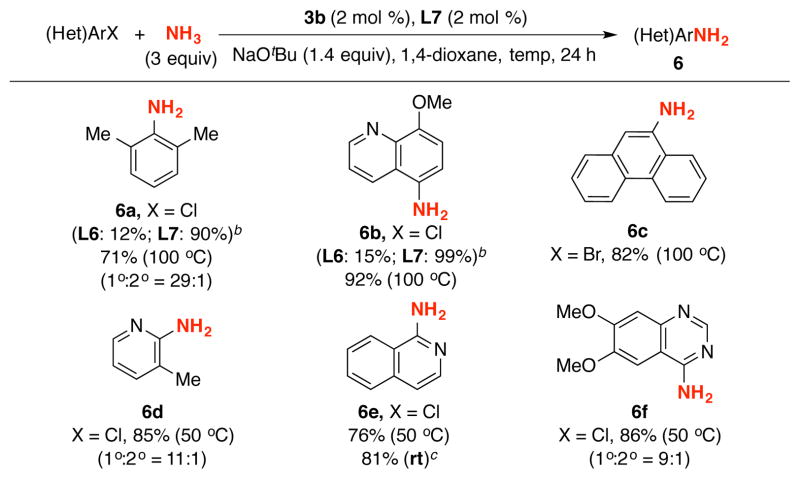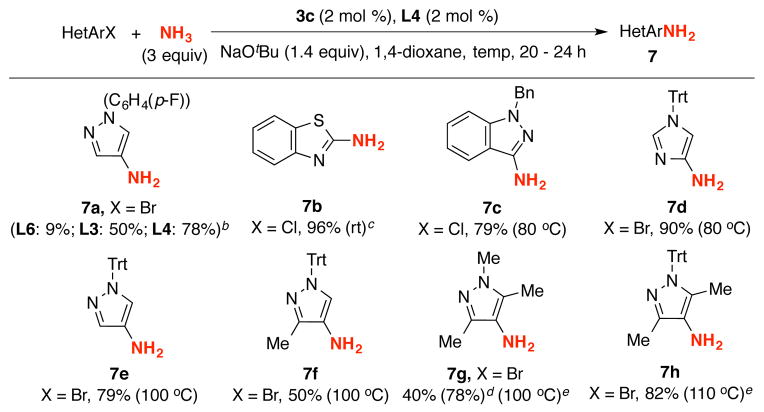Abstract
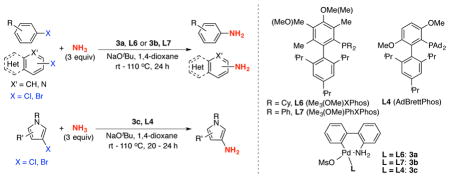
A method for the palladium-catalyzed arylation of ammonia with a wide range of aryl and heteroaryl halides, including challenging five-membered heterocyclic substrates, is described. Excellent selectivity for monoarylation of ammonia to primary arylamines was achieved under mild conditions or at room temperature by the use of bulky biarylphosphine ligands (L6, L7, and L4) as well as their corresponding aminobiphenyl palladacycle precatalysts (3a, 3b, and 3c). As this process requires neither the use of a glovebox nor high pressures of ammonia, it should be widely applicable.
Primary arylamines, including anilines and heteroarylamines, represent important structural elements found in dyes, polymers, pharmaceuticals, and agrochemicals.1 The presence of heteroarylamines and their derivatives is particularly ubiquitous in drugs as exemplified in a list of the top 200 pharmaceutical products by retail sales in 2011.2 Arylamines are traditionally prepared by the nitration of arenes followed by the reduction of the resulting nitroaromatics.3 However, the desired regioisomer of the nitroaromatics may be inaccessible via electrophilic aromatic substitution, and the use of nitric acid and strong acids often results in low functional group tolerance.3 Moreover, the reduction of nitroaromatics to arylamines may in itself pose an issue of chemoselectivity, further limiting the scope of this multistep approach. The transition metal-catalyzed cross-coupling between (hetero)aryl halides and ammonia provides a direct, regiospecific, and more atom-economical means to synthesize arylamines.4–6 Nevertheless, controlling the chemoselectivity for monoarylation of ammonia represents a significant challenge, since the resulting primary arylamine products are prone to undergo subsequent N-arylation to form undesired di- and triarylamine side-products.4,5 Ammonia surrogates have long been utilized in the synthesis of primary arylamines,7 but their use is significantly less atom-economical than the use of NH3.
A number of research groups including our own5 have reported the selective palladium-catalyzed arylation of NH3 to produce primary arylamines with minimal formation of diarylamine side-products. In the case of results from our group, we demonstrated that a Pd catalyst supported by the biarylphosphine ligand, tBuDavePhos (L1, Scheme 1), is reasonably effective for the selective production of the primary arylamines.5c
Scheme 1.

Pd-catalyzed selective arylation of NH3.
Despite the considerable advances, limitations remain. These include: (1) the coupling of aryl halides bearing base-sensitive (e.g., cyano and carbonyl) groups is typically problematic or provide anilines in lower yields when utilizing NaOtBu as the base.5 While one report detailing the use of K3PO4 has appeared,5b it necessitates the use of high pressure of NH3. (2) The substrate scope with respect to heteroaryl halides is generally limited to pyridines and (iso)quinolines,5 and the Pd-catalyzed coupling of NH3 with more challenging heterocylic substrates, such as diazines and five-membered heterocycles, is still unprecedented. Herein, we report the use of bulky biarylphosphine ligands and their corresponding palladium precatalysts that allow the highly selective arylation of NH3 to generate a wide range of anilines and heteroarylamines in moderate to excellent yields under mild reaction conditions.
Initial experiments focused on identifying optimal conditions for the Pd-catalyzed coupling of chlorobenzene with ammonia, utilizing 3 equivalents of NH3 and Pd2(dba)3 as the Pd source in a minimal amount of solvent (0.125 M) (Table 1). Although L1 was previously reported to be an excellent ligand for this transformation when 5 equivalents of NH3 and additional solvents were used (Scheme 1), the ratio of aniline (1) to diphenylamine (2) decreased significantly under these conditions (Table 1, entry 1). We proposed that the appropriate ancillary ligand could decrease the amount of 2, thus we proceeded to examine the effects of biarylphosphine ligands on the selectivity of arylation. We recently reported the use of sterically demanding ligands, Me4tBuXPhos (L2),8a tBuBrettPhos (L3),8b,c AdBrettPhos (L4),8d and RockPhos (L5),8e for the efficient cross-coupling of smaller nucleophiles (hydroxide,8a fluoride,8b,e chloride,8c and bromide8c) and five-membered heterocyclic electrophiles.8d As depicted in Table 1 (entries 2–5), ligands L2–L5 provided higher yields of 1 while concomitantly decreasing the formation of 2. To maximize the ratio of 1:2 further, we prepared and examined the effectiveness of new Me3(OMe)XPhos-type ligands L6–L9,9 which, like L2, contain a more conformationally rigid biaryl backbone as a result of the 3- and 6-methyl groups. We found that the yield of 1 further increased to 92% by using L6, which bears a dicyclohexylphosphine moiety (Table 1, entry 6). However, decreasing the size of the P-bound groups (L7 or L8) or increasing the size of the bottom aromatic ring (L9) resulted in a decreased ratio of 1:2 (Table 1, entries 7–9), and thus lower yields of 1. Considering our success in using air-stable aminobiphenyl palladacycle precatalysts,10 we prepared precatalyst 3a, in which the Pd center is pre-ligated with L6, as a source of Pd catalyst. In general, 3a was shown to be a superior Pd source as compared to the Pd2dba3/L6 catalyst, providing faster reaction rates and higher yields in the coupling of NH3 with various heteroaryl halides (See Table S1 in Supporting Information for comparisons).11
Table 1.
Ligand Optimization for the Selective Pd-catalyzed Arylation of NH3.a

| ||||
|---|---|---|---|---|
| entry | ligand | conv (%)b | yield of 1 (%)b | yield of 2 (%)b |
| 1 | L1 | 100 | 72 | 15 |
| 2c | L2 | 100 | 80 | 3 |
| 3 | L3 | 100 | 89d | 4d |
| 4 | L4 | 100 | 87 | 3 |
| 5 | L5 | 100 | 80 | 4 |
| 6 | L6 | 100 | 92d | 2d |
| 7 | L7 | 100 | 76 | 16 |
| 8 | L8 | 54 | 22 | 20 |
| 9 | L9 | 43 | 28 | 7 |
Conditions: PhCl (0.5 mmol), NH3 (1.5 mmol), NaOtBu (0.7 equiv), Pd2(dba)3 (1 mol %), ligand (5 mol %), dioxane (4 mL, 0.125 M), 80°C, 5 h.
Determined by GC.
13 h.
Average of two runs.
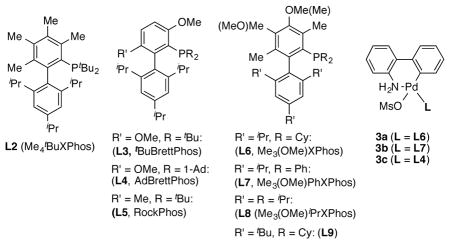
Next, we explored the scope of the Pd-catalyzed synthesis of anilines using the optimized conditions (Scheme 2). In the presence of 2 mol % 3a and 2 mol % L6, electron-rich (4a–4c, 4f), –neutral (4d), and –deficient aryl chlorides (4e, 4g–4k) could be aminated with NH3 under mild conditions to afford the corresponding anilines in generally high yields and with excellent selectivity. Remarkably, the base-sensitive cyano and carbonyl groups were reasonably well-tolerated under these conditions (4e, 4g–4k). Chlorobenzenes with vinyl groups (4l) as well as heteroaryl groups (4m–4o) also represent suitable coupling partners. Additionally, the reaction protocol was applicable to the coupling of disubstituted halobenzenes (4p–4v), including the substrates bearing fluoro- and trifluoromethyl groups (4r–4u) as well as unprotected NH2 groups (4t, 4v). As expected, bromides were found to react preferentially over chlroides bonds (4s, 4u, 4v), while 3,5-dichloroanisole could undergo double amination using excess NH3 (4w). Furthermore, at 110 °C, we demonstrated that an aryl halide could be coupled to form the aniline with less then 1 mol % precatalyst (4m).
Scheme 2.
Coupling with aryl halidesa
a Conditions: ArX (1 mmol), NH3 (3 mmol), NaOtBu (1.4 mmol), 3a (2 mol %), L6 (2 mol %), dioxane (10 mL, 0.10 M), 24 h; isolated products, average of two runs; ratios of arylamine to diarylamine (1°:2°) determined by 1H NMR. b 3a and L6 (2.5 mol %). c 3a and L6 (3–5 mol %), dioxane (0.143 M), 24–36 h. d 3a and L6 (0.7 mol %), dioxane (12 mL). e NaOtBu (2.2 mmol) fNH3 (6 mmol), NaO tBu (2.8 mmol), dioxane (13 mL); 2° amine identified to be 3,3′-diamino-5,5′-dimethoxydiphenylamine.
This reaction protocol using catalyst system 3a/L6 was also successful for the synthesis of an array of six-membered heteroarylamines with exceptionally high selectivity (Scheme 3). Various aminopyridines (5a–5f) and aminoquinolines (5g–5i) were successfully prepared under the conditions. Moreover, the NH2 group could also be readily incorporated into benzothiophene (5j) indole (5k), benzothiaole (5l), benzoxazole (5m), pyrazine (5n), quinoxaline (5o, 5p), pyrimidine (5q, 5r), pyridazine (5s), and carbazole rings (5t) as well.
Scheme 3.
Coupling with heteroaryl halidesa
a Conditions: HetArX (1 mmol), NH3 (3 mmol), NaOtBu (1.4 mmol), 3a (2 mol %), L6 (2 mol %), dioxane (10 mL, 0.10 M), 24 h; isolated products, average of two runs; ratios of arylamine to diarylamine (1°:2°) determined by 1H NMR. b 1H NMR yield of crude product. c NaOtBu (2.2 mmol). d 3a and L6 (3 mol %), dioxane (0.143 M). e HetArX (2 mmol), NH3 (6 mmol), NaOtBu (2.8 mmol), dioxane (13 mL).
Although L6 efficiently promoted the amination of a number of (hetero)aryl halides (Schemes 2 and 3), we found that the use of L6 resulted in incomplete conversion of more sterically hindered, ortho-substituted aryl halide and 5-chloro-8-methoxyquinoline (Scheme 4, 6a, 6b). However, high yields of various sterically hindered arylamines were obtained when a precatalyst based on its diaryl analogue L7 was employed under otherwise identical conditions (Scheme 4).
Scheme 4.
Coupling with bulky (hetero)aryl halidesa
a Conditions: (Het)ArX (1 mmol), NH3 (3 mmol), NaOtBu (1.4 mmol), 3b (2 mol %), L7 (2 mol %), dioxane (10 mL, 0.10 M), 24 h; isolated products, average of two runs; ratios of arylamine to diarylamine (1°:2°) determined by 1H NMR. b Conditions: (Het)ArX (0.25 mmol), NH3 (0.75 mmol), NaOtBu (0.35 mmol), Pd2dba3 (1 mol %), L6/L7 (4 mol %), dioxane (2.5 mL, 0.10 M), 100 °C, 24 h; 1H NMR yield of crude product. c 3b and L7 (5 mol %), dioxane (0.143 M).
Additionally, we found that the use of palladacycle precatalysts 3a and 3b also allowed for the coupling between (hetero)aryl halides and NH3 at room temperature to afford a range of arylamines in high to excellent yields (Scheme 2, 4b, 4f, 4i, 4k, 4o; Scheme 3, 5n, 5p; Scheme 4, 6e), albeit at higher catalyst loading (3–5 mol %).
Scheme 5.
Coupling with five-membered substratesa
a Conditions: HetArX (1 mmol), NH3 (3 mmol), NaOtBu (1.4 mmol), 3c (2 mol %), L4 (2 mol %), dioxane (10 mL, 0.10 M), 20–24 h; isolated products, average of two runs. b Conditions: HetArX (0.25 mmol), NH3 (0.75 mmol), NaOtBu (0.35 mmol), Pd2dba3 (1 mol %), L6/L3/L4 (4 mol %), dioxane (2.5 mL, 0.10 M), 120 °C, 20 h; 1H NMR yield of crude product. c 3c and L4 (5 mol %), dioxane (7 mL, 0.143 M). d 1H NMR yield of crude product. e 3b and L7 (2 mol %).
We have been particularly interested in transition metal-catalyzed processes with five-membered heterocyclic coupling partners8d,10c due to the ubiquity of these heterocyles in pharmaceuticals.2 Thus, we proceeded to study the coupling of NH3 with 4-bromo-1-(4-fluorophenyl)pyrazole as a test substrate (Scheme 5, 7a). While incomplete conversion and poor yields were observed when either L6 or L3 was used, with L4 (with the larger adamantyl group as the substituent on phosphorus) complete conversion was achieved to provide 4-aminopyrazole in 78% yield. In fact, using a catalyst derived from 3c/L4 (Scheme 5), the selective amination of a wide range of 5-membered heteroaryl halides was readily accomplished to provide various amino-substituted benzothiazoles (7b), indazoles (7c), imidazoles (7d), and pyrazoles (7e, 7f). While 3c/L4 was less effective for the coupling of 4-bromo-1,3,5-trimethylpyrazole, the use of a catalyst derived from 3b/L7 provided 4-amino-3,5-dimethylpyrazoles (7g, 7h) in good yields. Of note, the coupling of heterocyclic electrophiles with NH3 represents a convenient alternative method to synthesize five-membered heteroarylamines, since conventional methods, including cyclizations or annulations, typically involve the use of strong oxidizing agents or acids.12 To our knowledge, these examples represent the first Pd-catalyzed couplings between NH3 and five-membered heteroaryl halides, and particularly, challenging and important pyrazole and imidazole substrates.8d,10c
In summary, we have developed improved catalytic systems for the selective arylation of NH3 by using L4 and the new biarylphosphine ligands (L6 and L7). These reaction protocols allow for the synthesis of a broad range of functionalized arylamines, including six- and five-membered heteroarylamines, under relatively mild conditions and with an exceptionally high selectivity for monoarylation. We anticipate that this chemistry will be applicable to the general and convenient synthesis of biologically active molecules bearing arylamine functional motifs.
Supplementary Material
Acknowledgments
We thank the National Institutes of Health (GM58160) for financial support of this project. We are grateful to Mingjuan Su (M.I.T.) and Dr. Ye Zhu (M.I.T.) for insightful discussions, and Drs. J. Robb DeBergh (M.I.T.) and Nathan Jui (M.I.T.) for help with preparation of this manuscript. C.W.C. thanks the Croucher Foundation (Hong Kong) for a postdoctoral fellowship. The Bruker 400 MHz NMR spectrometer used in this work was supported by the National Science Foundation (Grants CHE-9808061 and DBI-9729592). M.I.T. has patents on some of the ligands and precatalysts used in this work from which S.L.B. receives royalty payments.
Footnotes
Supporting Information Available Experimental procedures and spectroscopic data. This material is available free of charge via the Internet at http://pubs.acs.org.
References
- 1.(a) Travis AS. Patai’s Chemistry of Functional Groups, Online. John Wiley & Sons, Ltd; New York: 2009. Anilines: Historical background. [DOI] [Google Scholar]; (b) Travis AS. Patai’s Chemistry of Functional Groups, Online. John Wiley & Sons, Ltd; New York: 2009. Manufacture and uses of the anilines: A vast array of processes and products. [DOI] [Google Scholar]; (c) Lawrence SA. Amines: Synthesis, Properties and Application. Cambridge University Press; Cambridge: 2004. [Google Scholar]
- 2.Vitaku E, Ilardi EA, Njarđarson JT. [Accessed on May 24, 2013];Top 200 Pharmaceutical Products by US Retail Sales in 2011. http://cbc.arizona.edu/njardarson/group/top-pharmaceuticals-poster.
- 3.(a) Hartwig JF, Shekhar S, Shen Q, Barrios-Landeros F. Synthesis of anilines In Patai’s Chemistry of Functional Groups, Online. John Wiley & Sons, Ltd; New York: 2009. [DOI] [Google Scholar]; (b) Fors BP, Buchwald SL. J Am Chem Soc. 2009;131:12898. doi: 10.1021/ja905768k. [DOI] [PMC free article] [PubMed] [Google Scholar]
- 4.For reviews, see: Klinkenberg JL, Hartwig JF. Angew Chem Int Ed. 2011;50:86. doi: 10.1002/anie.201002354.Enthaler S. Chem Sus Chem. 2010;3:1024. doi: 10.1002/cssc.201000145.Aubin Y, Fischmeister C, Thomas CM, Renaud JL. Chem Soc Rev. 2010;39:4130. doi: 10.1039/c003692g.Lundgren RJ, Stradiotto M. Chem Eur J. 2012;18:9758. doi: 10.1002/chem.201201195.
- 5.For Pd chemistry, see: Shen Q, Hartwig JF. J Am Chem Soc. 2006;128:10028. doi: 10.1021/ja064005t.Vo GD, Hartwig JF. J Am Chem Soc. 2009;131:11049. doi: 10.1021/ja903049z.Surry DS, Buchwald SL. J Am Chem Soc. 2007;129:10354. doi: 10.1021/ja074681a.Schulz T, Torborg C, Enthaler S, Schäffner B, Dumrath A, Spannenberg A, Neumann H, Börner A, Beller M. Chem Eur J. 2009;15:4528. doi: 10.1002/chem.200802678.Dumrath A, Lübbe C, Neumann H, Jackstell R, Beller M. Chem Eur J. 2011;17:9599. doi: 10.1002/chem.201100984.Lundgren RJ, Sappong-Kumankumah A, Stradiotto M. Chem Eur J. 2010;16:1983. doi: 10.1002/chem.200902316.Lundgren RJ, Peters BD, Alsabeh PG, Stradiotto M. Angew Chem Int Ed. 2010;49:4071. doi: 10.1002/anie.201000526.Alsabeh PG, Lundgren RJ, McDonald R, Johansson Seechurn CCC, Colacot TJ, Stradiotto M. Chem Eur J. 2013;19:2131. doi: 10.1002/chem.201203640.
- 6.For recent examples of Cu chemistry, see: Ji P, Atherton JH, Page MI. J Org Chem. 2012;77:7471. doi: 10.1021/jo301204t.Liao BS, Liu ST. J Org Chem. 2012;77:6653. doi: 10.1021/jo301244p.Huang M, Wang L, Zhu X, Mao Z, Kuang D, Wan Y. Eur J Org Chem. 2012:4897.Fantasia S, Windisch J, Scalone M. Adv Synth Catal. 2013;355:627.
- 7.For examples, see: Lee S, Jørgensen M, Hartwig JF. Org Lett. 2001;3:2729. doi: 10.1021/ol016333y.Huang X, Buchwald SL. Org Lett. 2001;3:3417. doi: 10.1021/ol0166808.Lee D-Y, Hartwig JF. Org Lett. 2005;7:1169. doi: 10.1021/ol050141b.
- 8.(a) Anderson KW, Ikawa T, Tundel RE, Buchwald SL. J Am Chem Soc. 2006;128:10694. doi: 10.1021/ja0639719. [DOI] [PubMed] [Google Scholar]; (b) Watson DA, Su M, Teverovskiy G, Zhang Y, García-Fortanet J, Kinzel T, Buchwald SL. Science. 2009;325:1661. doi: 10.1126/science.1178239. [DOI] [PMC free article] [PubMed] [Google Scholar]; (c) Pan J, Wang X, Zhang Y, Buchwald SL. Org Lett. 2011;13:4974. doi: 10.1021/ol202098h. [DOI] [PMC free article] [PubMed] [Google Scholar]; (d) Su M, Buchwald SL. Angew Chem Int Ed. 2012;51:4710. doi: 10.1002/anie.201201244. [DOI] [PMC free article] [PubMed] [Google Scholar]; (e) Maimone TJ, Miner PJ, Kinzel T, Zhang Y, Takase MK, Buchwald SL. J Am Chem Soc. 2011;133:18106. doi: 10.1021/ja208461k. [DOI] [PMC free article] [PubMed] [Google Scholar]
- 9.We have reported the synthesis of Me3(OMe)tBuXPhos from inexpensive 2,3,6-trimethylphenol, see: Ueda S, Ali S, Fors BP, Buchwald SL. J Org Chem. 2012;77:2543. doi: 10.1021/jo202537e. See Supporting Information for details of the synthesis of L6–L9.
- 10.(a) Bruno NC, Tudge MT, Buchwald SL. Chem Sci. 2013;4:916. doi: 10.1039/C2SC20903A. [DOI] [PMC free article] [PubMed] [Google Scholar]; (b) Bruno NC, Buchwald SL. Org Lett. 2013;15:2876–2879. doi: 10.1021/ol401208t. [DOI] [PMC free article] [PubMed] [Google Scholar]; (c) Yang Y, Oldenhuis NJ, Buchwald SL. Angew Chem Int Ed. 2012;52:615. doi: 10.1002/anie.201207750. [DOI] [PMC free article] [PubMed] [Google Scholar]
- 11.The use of Pd2dba3 (1 mol %)/L6 (4 mol %) and 3a (2 mol %)/L6 (2 mol %) were compared. See Supporting Information for details.
- 12.(a) Lefebvre V, Cailly T, Fabis F, Rault S. J Org Chem. 2010;75:2730. doi: 10.1021/jo100243c. [DOI] [PubMed] [Google Scholar]; (b) Telvekar VN, Bachhav HM, Bairwa VK. Synlett. 2012;23:2219. [Google Scholar]
Associated Data
This section collects any data citations, data availability statements, or supplementary materials included in this article.



